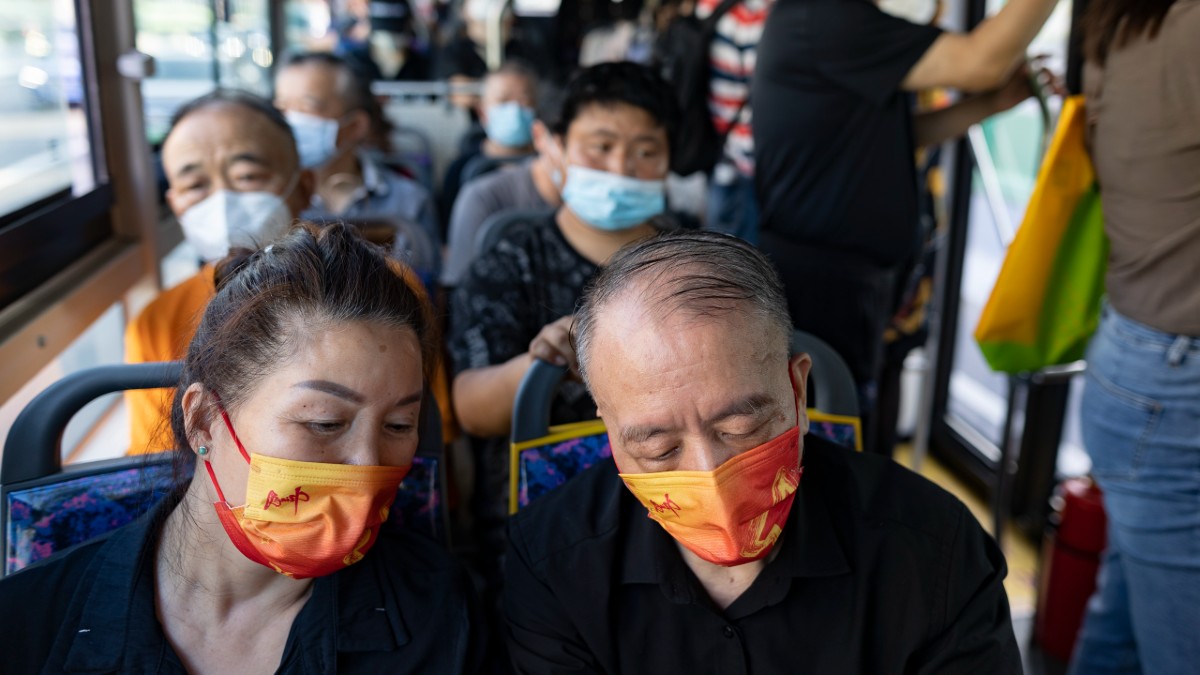Between a lock and a hard place: Shanghai’s got a 50-point economic rescue plan and a bunch of new infections

(Photo by Hu Chengwei/Getty Images)
Shanghai’s official coming out party hasn’t lasted long.
After a traumatic two-month COVID-19 lock-in lifted on Wednesday and residents emerged for the first time, city health authorities had already traced seven community infections by Friday in an inevitable self-checkmate as the city – and the world’s most populous country veer hopelessly toward the impossible goal of zero-COVID and economic recovery in one of the most congested cities on Earth.
Most of the city and its satellites, where global manufacturers from Samsung to Tesla’s Gigafactory 3 in Pudong are still running “closed loops.” The Shanghai composite is the same, where all employees are required to work, live and sleep in their workplaces or compounds at their factories to ensure zero contact with outsiders.
The no-quarter-given fist fight to stomp on the Omicron variant which both sidelined China’s central role in the global economy and decimated domestic activity is far from over, but for now authorities appear to be focusing on how to jumpstart the economy rather than struggle with the reality of Omicron’s infection rate or study the measure of public outrage.
As the highly-contagious variant refused to obey the instructions of President Xi Jinping – freely popping up across dozens of cities from Helionjiang in the north to Guangdong and Hong Kong in the south – the President’s plan of a smooth transition to his goal of an unprecedented third term has come under question for the first time.
With millions under full or partial lockdown in what swiftly became China’s worst COVID-19 outbreak since the pandemic first reared its butt-ugly little head back in Wuhan in 2019, Shanghai emerged as the new ground zero for much more than just China’s Zero-COVID “control and maximum suppression” strategy.
Full metal barriers blockaded the entrances to apartment blocks, supply chains broke down, hazmat suited officials kicked down doors and took away both the infected and quasi-close contacts. Foreigners freaked out, foreign direct investment dried up and all the while Xi Jinping was able to openly test the world’s greatest and most comprehensive security and control apparatus ever assembled.
This was a test of the modern party’s capacity to control, consume and digest even the slightest sneeze of individual dissent. And it was a fabulous success.
A standing army of willing party cadres emerged from each unit block delighted to wield the localised power their party affiliation promised as grim orange pop-up blockades pockmarked the entire city.
And all the while cutting-edge facial recognition software inside Shanghai’s ubiquitous and conservatively estimated 1 million surveillance cameras (some 408.5 cameras for every square mile) tracked anyone driven insane enough to take a peek outside.
Since near the end of March, anyone unlucky enough to be in Shanghai found themselves confined to their homes, hotels, hospitals or transported to makeshift infection camps turned the insanely sprawling metropolis of more than 25 million into a communist party-controlled ghost town.
The only hint of a cost for Xi Jinping comes from the general secretary’s historic and troubled relationship with the famed ‘Shanghai clique’ ( 上海帮 Shànghǎi bāng), an informal ‘gang’ of CCP boss Jiang Zemin’s Central Committee buddies who rose to prominence when Jiang ran the Shanghai municipal administration paving the way for the offspring of first generation party doyens. Widely known as princelings – like Xi himself – who leveraged their status as the children of revolutionary veterans to grow their own power base and dominate commercial and state run enterprise.
Much of Xi’s own power has derived from several incursions (2012 and 2020) back into Shanghai to break the last remnants of the Shanghai gang.
The memory of those heads rolling would’ve had ample time to be dusted off and reconsidered over the last few months.
China’s No. 2, Premier Li Keqiang, only last week held a State Council version of an emergency zoom with provincial level leaders of business and government on how to immediately resurrect the flatlining economy. Li is the head of the State Council – China’s governing body rather than its ideological (party) head. A distinction no one’s given much thought to in the age of Xi’s incredible grip on power.
With the four-yearly National People’s Congress set down for the autumn, these ancient but deep-running contours of Chinese power are emerging from the depths at exactly the wrong time.
According to the Shanghai Japanese Commerce and Industry Club, of the Japanese companies operating in Shanghai, more than one in eight plan to “reduce” or “postpone” future investments in China.
The city’s strict two-month-long lockdown was a heavy blow to the companies’ operations. China’s efforts to contain the spread of COVID through its ‘zero-corona policy’ may accelerate Japanese businesses’ ‘China plus one’ strategy — a movement that took flight among manufacturers, which have set up production facilities outside China as a solution to rising labor costs in the nation.
A survey result released on May 5 by the European Chamber in China, almost a full quarter (23%) responded that they were considering moving their Chinese investments to other markets.
And with a single post on its WeChat account, this week Amazon.com decided to quit its Kindle digital book business in China.
Amazon has already stopped sending new Kindle devices to resellers.
So in regards to COVID-19, until the new infections a day after reopening, total authority in Shanghai has been applied with not quite but almost complete, if not economic success.
But it wasn’t pleasant and the Shanghainese may struggle to feel proud, despite another WeChat message from the communist party to feel otherwise.
Maybe with this in mind, the sweeteners arrived.
On May 29, Shanghai unveiled a 50-point plan, the city deputy Wu Qing telling local media that there’ll be no more of these “unreasonable restrictions.”
I’ve read it. It’s party-painfully wordy (I’ll leave a link for the keen beans) and this will give you an idea:
Notice of the Shanghai Municipal People’s Government on Printing and Distributing the Action Plan for Accelerating Economic Recovery and Revitalisation in Shanghai
The people’s governments of all districts and the committees, offices and bureaus of the municipal government:
The “Shanghai Action Plan for Accelerating Economic Recovery and Revitalisation” is hereby issued to you, please implement it carefully.
(lots of love*) Shanghai Municipal People’s Government
*No they didn’t say that.
It’s long document – here’s the basic gist and some of the focal points
- All measures to whack the spread of COVID-19 including a return to work are now being reconsidered
- Companies will no longer need to be on a special whitelist to get back to work from Wednesday
- Increasing the intensity of tax rebates and tax reductions
- Like, tax breaks for new car buyers
- Local and commercial banks will now be encouraged to renew loans to SMEs and businesses targeting total provisions of $15 billion this year.
- Vouchers like the NSW ones will be made available via wechat (weixin) to help drive retaile and e-commerce spend
- Like ours, these are designed to be yummy stimmy for the comatose cultural, tourism and entertainment industries.
- Building approval accelerations (these never end well)
- Issuing and easier access to local government bonds
- China’s EV (electric vehicle) uptake will be accelerated with a strong gov-supplied subsidy
- The People’s Bank of China on Monday conducted 10 billion yuan (US$1.49 billion) of reverse repos to maintain liquidity in the banking system.
- This is where the PBoC buys securities from commercial banks and agrees to sell them back later on (a reverse repo)
- The central bank says this will guarantee stable liquidity
- All social insurance fees for food service, retail, tourism, civil aviation, land, water and rail transportation businesses are on hiatus
- That covers insurance and utilities support and subsidies
- Tax deadlines for individuals and companies are on pause
- A six-month rent reduction for small businesses renting from state-run landlords
- A near one-third waiver for private-owned properties which cut their tenants rent
- Property and land tax subsidies for qualified businesses
- 600 yuan for each worker a business didn’t lay off
- Companies that employ graduating students in 2022 or those who’ve been unemployed for three months or longer will get a 2000 yuan subsidy for each
- That’s enough
And while these measures may bring some relief to major employers and prospective car owners, on June 4 it’s probably worth sparing a thought for the incredibly proud cultural, social and stylistic engine of Shanghai – the youth.
Some of my warmest memories in that city are of straight backed Shanghainese girls striding metres ahead of harried young gents loaded down with the days shopping bags from the city’s endless array of fabulous shining malls.
In China this year there’ll be almost 10.8 million university graduates – the most ever in Chinese history. If the were a country they’d be more populous than Greece, Sweden or the Czech Republic.
At the same time, China’s logged its highest ever youth unemployment rate well over 18% of kids between 16 to 24 raised on the promise of success, if one worked hard enough to deserve it.
They’ll be disappointed. But hopefully they won’t be in lockdown again next week.
At midnight on Wednesday, greatly diminished Shanghai authorities started stripping back the startling metal blockades and yellow plastic barriers which’ve smothered one of Asia’s greatest cities.
And the previously effervescent Shanghainese spilled back into the gardens, streets and courtyards to celebrate the freedom this generation has never considered as lost.
At least they won’t be alone – on Friday the now state-aligned South China Morning Post reports as many as two million ‘digital sentry’ machines could be deployed in public venues in the coming weeks.
The sentry machines use facial recognition technology to check and record information about individuals. Where they live, who they live with, their vaccination and Covid-19 test status, their recent movements and who they’ve come across – before being granted access to public venues.
UNLOCK INSIGHTS
Discover the untold stories of emerging ASX stocks.
Daily news and expert analysis, it's free to subscribe.
By proceeding, you confirm you understand that we handle personal information in accordance with our Privacy Policy.








